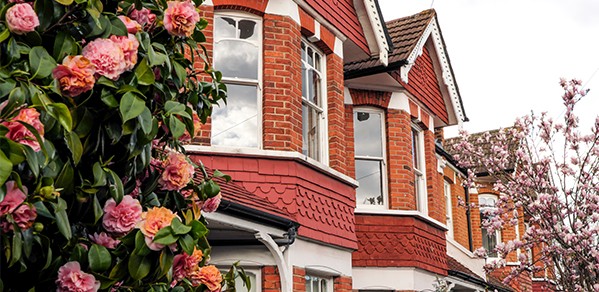
England is in the midst of a housing affordability crisis and the country’s population is still growing. So how do we meet society’s housing needs without relying on emissions-intensive housing expansion that potentially conflicts with England’s climate and biodiversity targets? The answer lies in navigating trade-offs between nature and infrastructure construction, say researchers.
We face a future of energy restraint, and our housing stock is old and leaky. In addition to electrifying all energy uses, there is an urgent need to insulate old houses. The faster this is done, the more headroom there will be in England’s carbon budget for the most difficult sectors to decarbonise.
Dr André Cabrera Serrenho
In a new review of the potential conflicts that exist between housing and sustainability objectives, a cross-disciplinary research team1 explore the impact of current English government housing policy, and alternative housing strategies, on national carbon and biodiversity goals. Their findings are reported in the journal Ecological Economics.
‘Safe and affordable housing for all’ makes up one of the 17 Sustainable Development Goals (SDGs) which outline humanity’s aspirations for achieving high living standards for all, without harming nature or modifying the climate system. With this in mind, the researchers explored solutions for simultaneously achieving infrastructure and housing-related SDGs – numbers 9 (industry, innovation and infrastructure) and 11 (sustainable cities and communities) – as well as ecological SDGs – numbers 13 (climate action) and 15 (life on land).2
The study identifies alternative pathways to meeting England’s housing needs without undermining national sustainability objectives. Government policy is to deliver 300,000 homes per year by the mid-2020s. The researchers have modelled this scenario of 300,000 new homes added every year by 2050 and estimate that it risks consuming the entire national cumulative carbon budget – consistent with 1.5°C global warming – by 2050. Broken down, this amounts to 104% of England’s carbon budget; 12% from the construction and operation of new builds and 92% from the existing housing stock.
With home energy and electricity use representing one-fifth of total emissions3, the researchers say rapid retrofitting of existing housing stock is needed, alongside decarbonising the electricity grid, so that homes are zero carbon by 2050 – potentially saving 38% of the national cumulative carbon budget for 1.5°C. This approach is based on the government’s business-as-usual housing strategy which extends current decarbonisation trends i.e. electrifying heating and improving home insulation and energy efficiency, whilst also achieving its construction targets. It is an approach that has the most impact for reducing housing’s conflict with climate targets, say the researchers, but not biodiversity.
With biodiversity in mind, the researchers used land use change models to predict housing expansion to generate a high-level estimate of the biodiversity impact of predicted housing expansion without policy action. From this information, a rough picture can be formed of how effective ‘Biodiversity Net Gain’ and species mitigation policies need to be to stop biodiversity loss from housing expansion from now to 2030. ‘Biodiversity Net Gain’ is an approach that aims to resolve trade-offs between new construction and impacts on nature, with an emphasis on leaving biodiversity in a better state than in which it was found – but its effectiveness is unproven. From late 2023, the 2021 Environment Act will mandate that all new housing developments achieve a ‘Biodiversity Net Gain’ – an important consideration to ensure developments do not conflict with England’s 2030 wildlife abundance targets.
In addition to slowing the rate of housebuilding, increasing the environmental standards of new builds can also play a role in meeting society’s housing needs, ensuring that they achieve zero carbon and no net impact on wildlife populations, say the researchers, and all without relying on emissions-intensive housing expansion.
Contributing author Dr André Cabrera Serrenho, from the Department of Engineering, University of Cambridge, said: “We face a future of energy restraint, and our housing stock is old and leaky. In addition to electrifying all energy uses, there is an urgent need to insulate old houses. The faster this is accomplished, the more headroom there will be in England’s carbon budget for the most difficult sectors to decarbonise.”
Contributing author Dr Michał P. Drewniok, from the University of Leeds, and a collaborator on the Resource Efficiency Collective at Cambridge, said: “We are legally obliged to meet our climate goals. Unused building stock, both residential and non-domestic buildings, can help meet housing needs as well as meet agreed targets. There is a need for a rapid and adequate modernisation of the existing buildings. This includes all pre-1944 buildings – almost 40% of domestic building stock in England.”
Reference:
Sophus O.S.E. zu Ermgassen; Michal P. Drewniok; André Cabrera Serrenho, et al. ‘A home for all within planetary boundaries: Pathways for meeting England's housing needs without transgressing national climate and biodiversity goals.’ Ecological Economics (2022). DOI: 10.1016/j.ecolecon.2022.107562
---
1 From the Universities of Cambridge, Kent, Bath, Leeds and Surrey, in collaboration with the Land, Environment, Economics and Policy Institute (LEEP) and the UCL Institute for Innovation and Public Purpose (IIPP).
2 The SDGs sit at the heart of a shared blueprint adopted in 2015 by all United Nations Member States and are an urgent call for action by all developed and developing countries as part of a global partnership.
3 UK Housing: Fit for the Future? Committee on Climate Change, London, 2019, p11.

